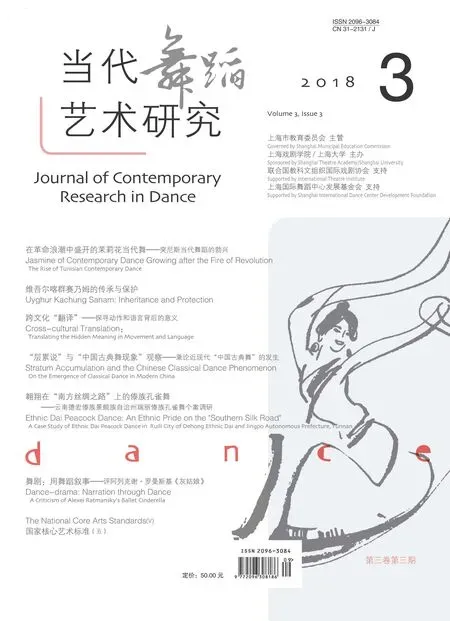当代建构的“古典”—“中国古典舞”的美学基准
2018-01-24苏娅
苏 娅
一、今日之困:纠结中的“中国古典舞”
“中国古典舞”与西方芭蕾舞长久以来的“不解之缘”,实则源于中国自20世纪初期五四运动以来所一直延续的,试图通过学习西方解决本土问题的文化心态。诞生于新中国成立后的“中国古典舞”学科以明确的时空坐标彰显出内含的当代性质:草创于20世纪50年代的“中国古典舞”,既以“古典”之名从京昆戏曲、武术等形态中吸收了大量的本土身体元素,又在具体的型构过程中借鉴了彼时“苏联老大哥”所提供的语法模本—芭蕾。如首演于1957年的作品《春江花月夜》,即体现出以戏曲元素为血肉、以芭蕾语法为骨架的鲜明特征。如剥离开作为语词的戏曲元素本身及其显现出的古典风格,《春江花月夜》仍旧顺延了芭蕾的内在结构逻辑。流变至今,这一脉络伴随着“身韵”的出现而有所改观。可以说,“身韵”是对既往“中国古典舞”中鲜明的芭蕾语法的直接回应,是意图建立起本土身体运动逻辑的努力与探索,在这一脉络下诞生的作品的确在一定程度上填补了彼时“中国古典舞”内部身体运动逻辑的缺位。《扇舞丹青》《爱莲说》等系列作品的出现,也成为源自武术、戏曲的传统身法与“中国古典舞”化合的明确显影。而与此同时,芭蕾外开挺拔的美学准则也已深深刻印在“中国古典舞”的身体之中:以我国青年舞蹈家王亚彬表演的“中国古典舞”作品《扇舞丹青》为例,该作品在表现出以舞蹈化的戏曲、武术作为运动路径的同时,也明确显现了西方芭蕾舞外开挺拔的美学标准。即是说,“中国古典舞”自诞生之日起就是以昨日之名建立的今日身体,是今人构想的昨日,是当代建构的“古典”。
因此,“中国古典舞”这一不断生长的生命体,其DNA本身包含着传统舞蹈与芭蕾两方面。两者在此中已然形成和解,“中国古典舞”的美学即是和解的产物。若其发展纠结于回溯传统或是向多元世界打开,任何一种选择的做出,都是对DNA的分裂和破坏,最后得到的都不再是原本之物。故而笔者认为,我们的前辈创造出的“中国古典舞”虽然承受着许多争议,但从近代以来的历史中可见,它已然被专业人士和大众所接受。历史的牵绊,使得我们已经不可能在这个和解的整体之外,对它做出单向选择。所以长期以来我们对于“中国古典舞”应如何前行的困惑,实为非困之困,不惑之惑。缺少的不是选择,而是需要明确一个原则或限定条件,来作为“中国古典舞”的美学基准,确保“中国古典舞”的发展不至偏离或脱轨。
二、多元探析:选择中的“中国古典舞”
显而易见,当下的“中国古典舞”学科面临着两种相互悖逆的发展路径:其一,严格按照“古代”“典范”这两种要求划定自身,将“中国古典舞”严格框定在表达中国古代的范畴内部。如学习至今仍在流传的祭祀舞蹈,并同时根据严谨的学术考究复现历史中曾经有过的中国乐舞作品。其二,将草创、建立在当代的“中国古典舞”学科视为完全意义上的新舞蹈艺术进行发展。而这两种发展方向似乎对于“中国古典舞”学科而言也都存在着问题:如果我们选择仅停留于完整复现历史中的“中国古典舞”,完成逆行之旅,势必无法满足已在全球化语境中改变了自身时空感受、审美诉求等方方面面的当代中国人的内在心理结构,势必会造成其与当代关系的萎缩;而如果我们将“中国古典舞”视作完全意义上的新舞蹈,那么我们就极易丢失中国传统赋予国人身体形态的文化特质。实则,当我们仅将“中国古典舞”的发展路径局限于以上两种选择之中,我们也同时将自身局限在了二分法的思维和界限之中。而当我们总是习惯于在非此即彼的首尾两端进行探究时,就势必会造成“非我即他”的固化思维模式。然而,“中国古典舞”学科难道当真仅仅局限于这两条互斥的发展路径中吗?我们何不在这一问题上以更为多元的思考路径进行全新的探索?
三、民族为根:“中国古典舞”的美学基准
笔者认为,中国传统舞蹈必定是扎根于本民族的文化土壤,扎根于以民族传统为基础建立起的美学基准。中国的民族舞蹈传统历史如此悠久、丰富,必然在其基础上建立起中国自己的民族的舞蹈美学基准。值得注意的是,这里所指的传统绝不能是一成不变的形式和内容,它必须和舞蹈文化建设的需要紧密结合起来。如此,我们必定要沿着对民族传统审美内涵的挖掘与思考来建设自身的审美准则:
(1)“圆”“转”—中国古典舞的根本动律:任何艺术形式,作为人自身意识活动的载体,总有其发生、发展的基本逻辑,而其中必有一种最为本质的核心规律,因它的存在,决定着该门艺术的基本走向和系统构成。中国舞蹈运动规律的核心就是“划圆”。“划圆”动律在“中国古典舞”中得到了最充分、最集中的体现。
(2)“子午阴阳”“反身而诚”—“中国古典舞”的辩证运动观:在上面关于“圆”“转”的简要论述中,我们已经涉及了左右舞蹈人体运动趋势的内在动因—组成“太极”的阴阳两极—冲突与解决、对立而统一的变化本性。人体运动的根本之道,在于“一阴一阳”和“反者道之动”。内、外“三合”形成的人体运动“太极球”模式,同样离不开自身上下、前后、内外、腹背的阴阳相和;任何一轴的形态圆满,有赖于内“气”阴阳二者的循行流变。
(3)“以意为帅”—“中国古典舞”人体运动之“和”的基本要求:宏观上,“中国古典舞”作为意象艺术,由其自身形、意、情构成“有意味的形式”。这其中之“意”,涵盖甚广,融括宇宙、生命、思维、运动等多重内容,实际是一种“意象”。“以意为帅”是舞蹈“以神领形”“以形传神”“形神兼备”的基本保证。
四、明日瞭望:文化主体立场下的开放与包容
和中国的民族民间舞一样,“中国古典舞”并非一个在历史中已被划定具体时空坐标的静止概念,而仍处在不断发展的过程中,其必须根据当下语境来进行构建。正如中国舞蹈史学家彭松先生说的,民族民间舞蹈应该像一条大河,既有源头活水,也需不断汇入新流。当下的中国文化正在建构自身的新古典与新传统,即是说,在中国传统审美的映照下,基于对西方芭蕾舞、现代舞以及中国戏曲、武术等身体样貌的认知,我们都在以自身的传统文化构建当代的“中国古典舞”。于此,“中国古典舞”的当下发展势必需要打破以历史传统为参照进行建构的单一路径:其一,打破边界。一方面,“中国古典舞”要以传统为本,做到“古为今用”,继承来自我国历史进程中的优秀传统文化;另一方面,“中国古典舞”也要以“洋为中用”的态度汲取世界各国的多元舞蹈文化。其二,创造价值。“中国古典舞”应以“立足当下”的观念嵌入当代的大众审美,无论是古典人物、古典意韵还是古典精神,其最终目的都要服务于当代的中国人,创造能直接作用于当代中国的自我价值。其三,开放心态。值得警醒的是,不论是打破边界还是创造价值,都要求我们在保持自身宽阔视野的同时,不断进行革新主体是否仍旧具备起码的自主性的自问,不断要求我们站在本民族、本国家的审美立场上体现独到的文化主体立场。因此,开放的心态并非意味着自我毫无立场的开放与包容,而意味着以清晰的主体立场作为前提的兼容并包。进而,才能助力“中国古典舞”破除文化障碍与隔阂,打破边界与惯性,积极融入全球化格局。
A “Classic” Built in the Present: Aesthetics of Chinese Classical Dance
Su Ya
[Abstract]
l.Chinese classical dance in confusion
Chinese classical dance has an inseparable relationship with ballet.This relationship stemmed from a cultural development strategy in China first adopted in the 1910s that encouraged artists to address domestic cultural problems through learning from the West.Born in the 1950s, Chinese classical dance, a modern art to a great extent, contains multiple genes.In the name of being “classical”, it has not only absorbed movement language from Chinese operas (Xiqu), but also borrows the grammatical structure of ballet from the Soviet Union.The new concept of body rhyme (shenyun), as a series of new theories and discourses of Chinese classical dance, breaks down the balletic grammar and aims to establish a unique Chinese corporeal logic.It is behind the creation of many contemporary classical works that have gained popularity and recognitions.Meanwhile, it incorporates ballet aesthetics such as open torso and legs.In this sense, Chinese classical dance has always been a contemporary body language that tells the past, or in other words a “classic” built in the present.It would meet with challenges and opportunities in a global context,where China and the West of the past and present mingle into one body to represent Chinese culture.
ll.Chinese classical dance facing choices
Opposing the strategy of solving domestic cultural problems by learning from the West, Prof.Sun Ying of Beijing Dance Academy advocated the Han-Tang style classical dance at the end of the 20th century.Prof.Sun Ying abandoned ballet aesthetics but used the physical logics of Chinese operas dating back centuries.Han-Tang style has gradually developed its own unique language and aesthetics.Given Han-Tan style’s success, Chinese classical dance, as a discipline lasting only 60 years, should reconsider its future route.Two apparent choices are: to take a similar strategy with Han-Tang style and remove the influence of ballet; or to restage ritual performances that are still popular in China or revive performances in ancient China through literature study.However, both choices have problems.If the influence of ballet is completely removed,the remaining vocabulary could not support Chinese classical dance alone.Ifits development is to depend on reproducing ritual or ancient Chinese dance, Chinese classical dance would retreat to the “stone age”, which would problematize its identity.
lll.Rooted in Chineseness: Aesthetics of Chinese classical dance
Chinese classical dance should be always rooted in the Chinese tradition.China’s abundant history provides a foundation for Chinese dancers to establish a set of aesthetics that belong to China.Here, tradition does not refer to a fixed system of form or content, but it crystalizes the key corporeal logics in China’s performing arts.The following aesthetic principles are suggested to guide the creation of Chinese classical dance:
(1) Circle-Spiral: The founding logic
Any art form, as an externalization of human thoughts, possesses its unique logic.Circles represent the key logic of Chinese classical dance.From circling movements, Chinese classical dance develops a spiral body that gives birth to a new system of vocabulary.
(2) Yin-Yang: The dialectical concept
Yin and Yang manifest their relationship in Chinese classical dance through a Tai Chi pattern of movements:the combination of internal and external perspectives, the contrast between the upper body and the lower body, and the circulation of qi.Yin and Yang symbolize the driving force of any movement generated through harmonizing contradictions and oppositions.
(3) Yi: The basic requirement of harmony
Chinese classical dance, like many other Chinese traditional arts, highlights symbolic images.Yi embraces a wide range of meanings of the world, life, thought and movement, and centers on a symbolic image.Focus on yi helps dancers to “let spirit lead form,” “let form convey spirit,” and “let form and spirit exist in harmony.”
lV.Looking forward: Openness and embraciveness
Similar to Chinese folk dance, Chinese classical dance is not a static concept pinned down in a specific time and history framework.Instead, it is still developing and its reconstruction should be based on the current circumstances of China.According to Peng Song, a renowned dance historian in China, “Chinese dance is like a river.It has an origin, but also needs new branches coming in.” The contemporary Chinese culture is influencing the reconstruction of a new tradition, while ballet, modern dance, Chinese operas, and martial arts constitute Chinese traditional aesthetics.Therefore, the future development of Chinese classical dance needs to take multiple approaches.First, to be courageous.First, Chinese classical dance should cross the borders and absorb external cultures to “let the foreign serve the domestic.” On the other hand, Chinese classical dance should try to inherit traditional cultural essence to “let tradition serve the present.” Second, Chinese classical dance should focus on the present to create value.Whether it portrays a historical figure, image,or spirit, Chinese classical dance serves contemporary needs.Third, Chinese classical dance should be open.An open attitude does not mean it must accept whatever is foreign and new, but it should embrace new and external elements.In so doing, Chinese classical dance could break down the barriers between borders and habits to create a strong momentum for global civilizations.
[Keywords]
“Chinese classical dance,” aesthetics, modern construction
